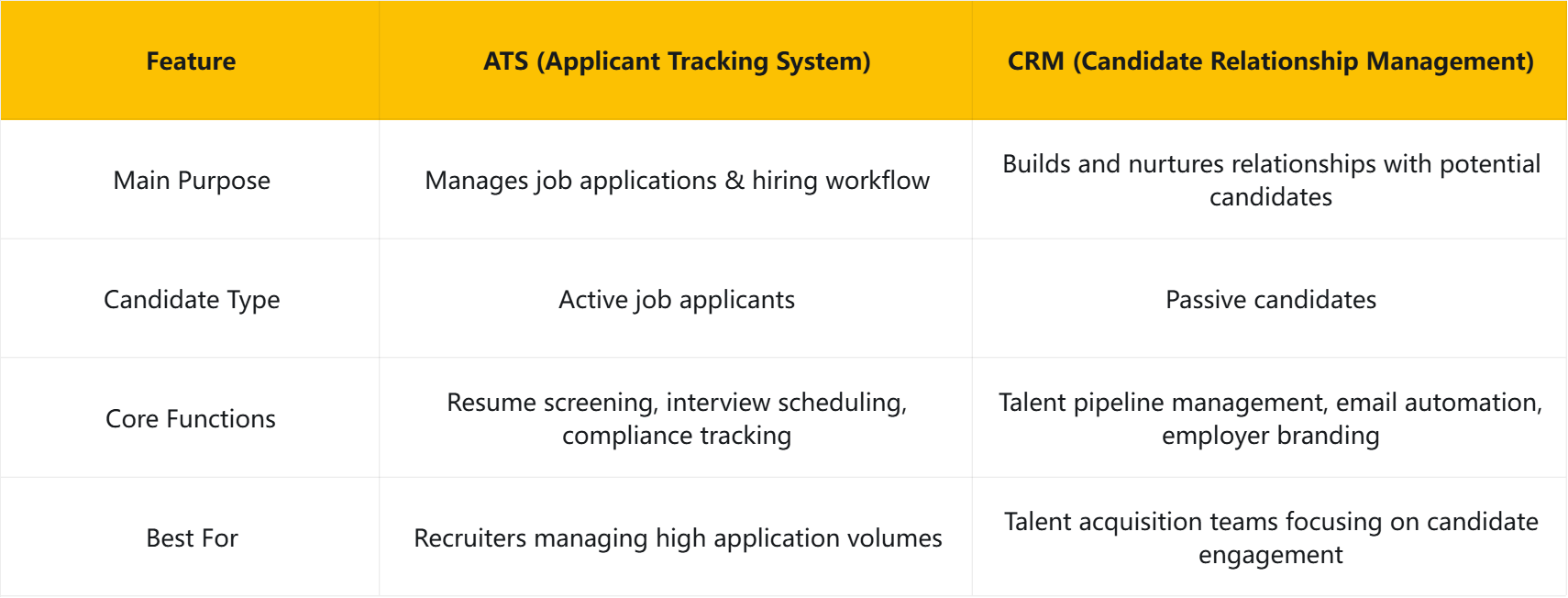ATS vs. CRM: Which Recruiting Software is Best for Your Hiring Strategy?
Introduction: Understanding ATS and CRM in Recruitment
When it comes to recruitment software, two essential tools dominate the hiring landscape: Applicant Tracking Systems (ATS) and Candidate Relationship Management (CRM) systems. While both are crucial for modern talent acquisition, they serve different purposes.
An ATS helps recruiters track, manage, and organize job applicants, while a CRM focuses on building long-term relationships with passive candidates. If you’re wondering whether an ATS or CRM is better for your business, this guide will break down their differences, benefits, and best use cases.
What is an Applicant Tracking System (ATS)?
An Applicant Tracking System (ATS) is a software solution that helps HR teams and recruiters streamline the hiring process by automating resume screening, interview scheduling, and candidate tracking.
Key Features of an ATS:
Resume Parsing & Screening: Automatically filters resumes based on keywords, skills, and qualifications.
Job Posting & Distribution: Posts job openings across multiple job boards like LinkedIn, Indeed, and company career pages.
Candidate Tracking: Keeps track of applications at every stage, from submission to hiring.
Interview Management: Schedules interviews, collects feedback, and automates communication.
Compliance & Reporting: Ensures compliance with hiring regulations (EEOC, GDPR) and provides recruiting analytics.

Best Use Cases for an ATS:
Companies that receive high volumes of applications and need a structured hiring process.
HR teams looking to automate administrative tasks in recruiting.
Businesses hiring for multiple job openings at the same time.
Popular ATS Platforms:
MokaHR – AI-powered applicant tracking system with smart resume screening and automated hiring workflows.
Greenhouse – A data-driven ATS with strong interview management and candidate experience tools.
Lever – Combines ATS and CRM features, ideal for collaborative hiring.
Workday Recruiting – Enterprise-level ATS integrated with HR management software.
iCIMS – A scalable ATS with recruitment marketing and automation capabilities.
What is a Candidate Relationship Management (CRM) System?
A Candidate Relationship Management (CRM) system is a recruitment software designed to help companies build and maintain relationships with potential candidates before they apply for a job.
Key Features of a CRM:
Talent Pipeline Management: Stores and organizes passive candidates for future hiring needs.
Automated Candidate Engagement: Sends personalized emails, job alerts, and recruitment marketing campaigns.
Employer Branding & Recruitment Marketing: Helps companies enhance their reputation and attract top talent.
Social Recruiting & Referrals: Integrates with LinkedIn, Facebook, and employee referral programs.
AI-Powered Talent Matching: Uses machine learning to recommend relevant job opportunities to potential candidates.
Best Use Cases for a CRM:
Companies with long hiring cycles that want to engage talent before job openings arise.
Businesses looking to attract passive candidates and reduce time-to-hire.
Organizations that focus on employer branding and talent acquisition marketing.
Popular CRM Platforms:
Beamery – AI-driven candidate relationship management system with predictive analytics.
Avature – A customizable CRM designed for global recruiting teams.
Yello – Specializes in campus recruiting, talent pools, and virtual hiring events.
SmashFlyX – Combines recruitment marketing automation with candidate engagement tools.
Phenom – Focuses on AI-driven recruiting and personalized candidate experiences.
ATS vs. CRM: Key Differences

💡 Pro Tip: The best recruiting strategies combine ATS and CRM to maximize hiring efficiency and talent attraction.
Frequently Asked Questions (FAQs)
1. Do I Need Both an ATS and a CRM?
Yes! Many companies integrate both systems—an ATS for active hiring and a CRM for long-term candidate engagement.
2. Can an ATS Function as a CRM?
Some modern ATS platforms (like Lever) include basic CRM features, but they lack the recruitment marketing and automation capabilities of a true CRM system.
3. What’s the Best ATS for Startups?
For small businesses and startups, MokaHR, Lever, and Greenhouse offer user-friendly ATS software with automation tools.
4. How Can a CRM Improve Hiring Efficiency?
A CRM for recruitment keeps potential candidates engaged with automated job alerts, newsletters, and personalized messages, reducing time-to-hire.
5. Which System Helps Reduce Recruitment Costs?
A CRM helps reduce hiring costs by maintaining a talent pool, reducing reliance on job ads and external recruiters. An ATS reduces administrative costs by automating resume screening and interview scheduling.
Conclusion: Choosing the Right Recruiting Software
If your company needs to streamline hiring and manage job applicants, an ATS is essential. If you want to build long-term relationships with candidates and improve employer branding, a CRM is the better choice.
For companies serious about scaling their hiring strategy, using both an ATS and CRM together provides the best results. By leveraging AI recruiting, recruitment automation, and talent relationship management, businesses can stay ahead in today’s competitive job market.
🚀 Want to optimize your hiring process? Explore MokaHR’s ATS and discover how AI-powered recruitment can transform your talent acquisition strategy.
From recruiting candidates to onboarding new team members, MokaHR gives your company everything you need to be great at hiring.
Subscribe for more information

